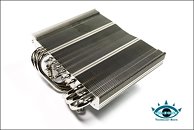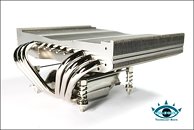Friday, December 26th 2008
Thermalright AXP-140 Heatsink Pictured
Thermalright, best known for its aluminum fin heatsinks devised the AXP-140 CPU heatsink for HTPCs, that is low-profile friendly with a height of 7 cm. VR-Zone unboxed the heatsink to take a few pictures.
The AXP-140 supports Intel processors on the LGA-775 socket. It consists of a thick nickel-plated copper CPU contact block from which six aluminum heatpipes convey heat to an aluminum fin array. Unlike conventional heatsinks from Thermalright, the array propagates horizontally along the plane of the motherboard. The dimensions of this heatsink are 145 x 147 x 70.2 mm (L x W x H). It weighs 900 g (1.98 lbs). Although this heatsink could cool some processors with low TDP passively for a silent operation, a 120mm fan can be attached to it for active air-cooling. The AXP-140 is expected to be priced at US $59 when it hits the stores.
Source:
VR-Zone
The AXP-140 supports Intel processors on the LGA-775 socket. It consists of a thick nickel-plated copper CPU contact block from which six aluminum heatpipes convey heat to an aluminum fin array. Unlike conventional heatsinks from Thermalright, the array propagates horizontally along the plane of the motherboard. The dimensions of this heatsink are 145 x 147 x 70.2 mm (L x W x H). It weighs 900 g (1.98 lbs). Although this heatsink could cool some processors with low TDP passively for a silent operation, a 120mm fan can be attached to it for active air-cooling. The AXP-140 is expected to be priced at US $59 when it hits the stores.



17 Comments on Thermalright AXP-140 Heatsink Pictured
Edit: It is made of copper lol. My mistake.
It will be interesting to see what the AXP-140 can do, my Thermalright SI-128 will keep a Q6600, OC to 3.5 GHz in the low 50's Celsius at full load, and the SI-128 is 400 grams lighter.
I shouldn't bag TR though, they make some damn good H.sinks :)
Also, the base looks like the same bas as the Ultra-120, so I don't see why the AM2 mounting hardware from an Ultra-120 wouldn't work on the AXP-140, though I can't be sure without having the two directly in front of me.